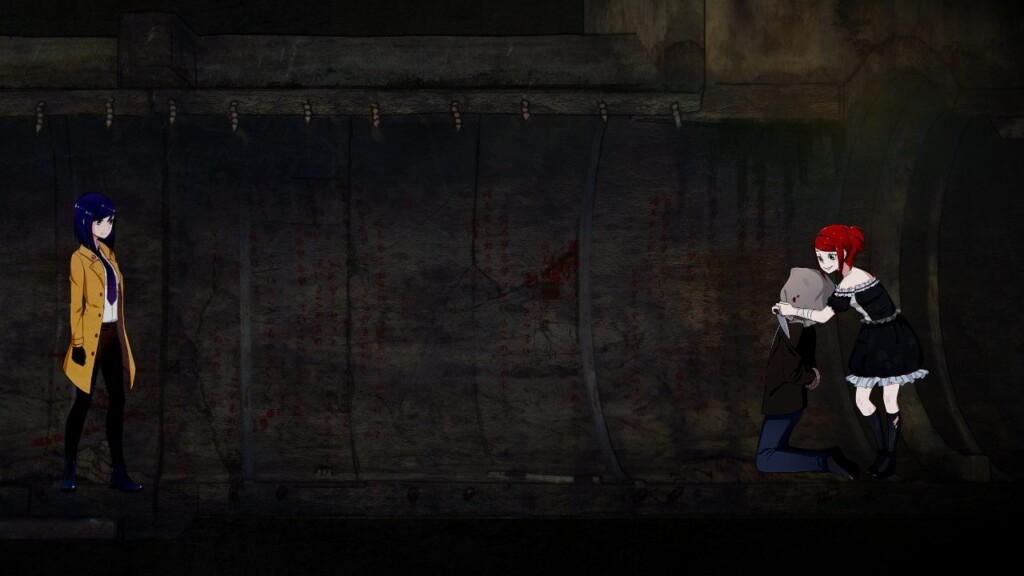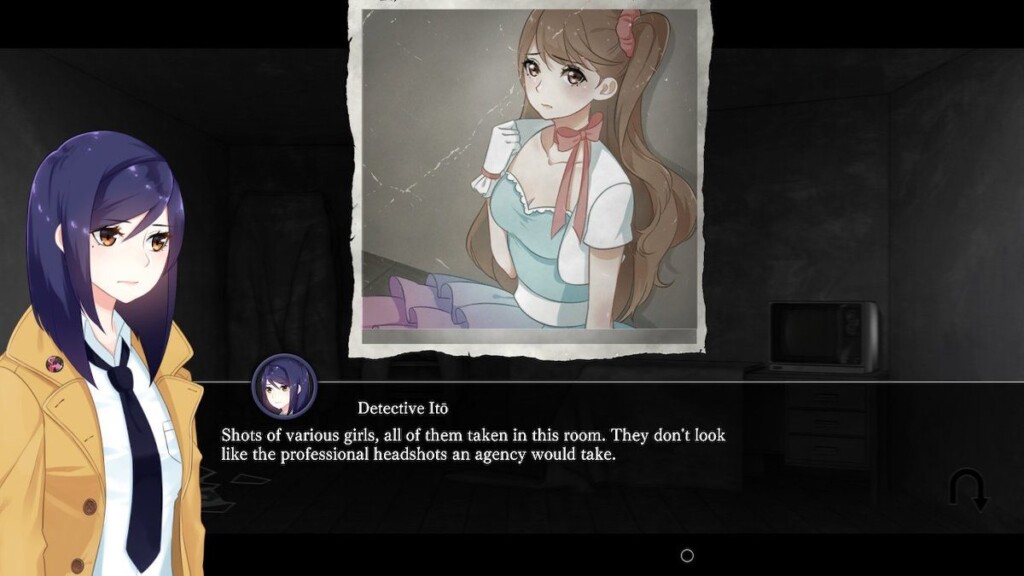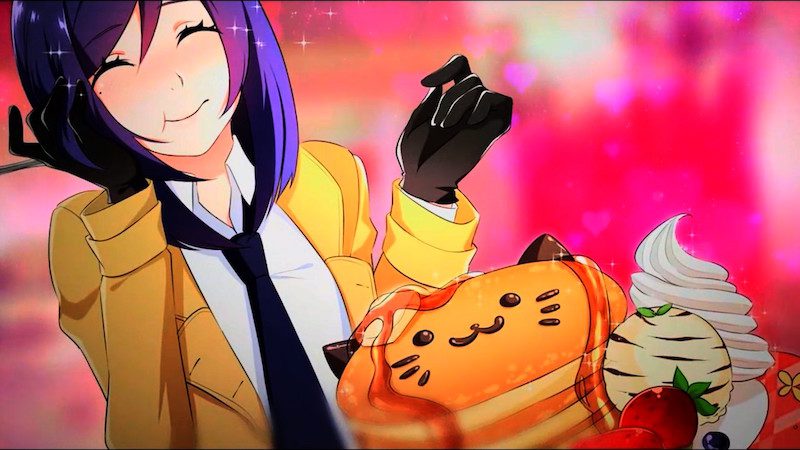Tokyo Dark Remembrance is a hard game to pin down, especially if you only have screenshots to go off on. I’ve had this one floating through my emails for a while and I just could never wrap my head around just what the game wants to be. Now having played the game, I can’t say I’m in any better of position, although I did enjoy my experience narratively with the game, if not with the bland and thin gameplay.
Tokyo Dark Remembrance on the surface is a point-and-click adventure game that sees you fill the shoes of a detective on the hunt for a killer that’s been on the loose; a killer that you already put a bullet squarely between the eyes and managed to come back and take the life of your partner. It’s a bloody great premise that easily draws in the player on the hunt for answers.
The story ups the intrigue as underneath everything is a horror element that continues to rise to the surface as your sanity begins to slip away. Tokyo Dark Remembrance is great at pulling from real-world events and serious issues that Japan is facing throughout its 10-or-so hour run. The game’s underlying cult is inspired by several real-world cults and even brought to mind the rise in Japanese cults in the late 80s and early 90s.

On top of that is a story of emotional, physical, and sexual abuse that surrounds the games central antagonist. She is as much a victim as there can be and her quest for a mysterious mask, a mask that comes into your possession, becomes more painful as her backstory comes to light. This isn’t a villain you root for or against, but rather one you sympathize with and begin to understand.
Tokyo Dark Remembrance plays on some really heavy themes, more so than you might expect from just looking at it. Dealing with mental health problems in a way that doesn’t stigmatize them is a delight. Both you as the detective and the main villain are facing mental health issues and taking your medication is vital in helping to keep your sanity meter in check. Not taking them during the course of the investigation opens you up to hallucinations and seeing the world around you in an altered state, much as out villain does.
You begin to question what is real and what isn’t. You start to connect the dots while trying not to lose yourself down a path you can’t walk back from. You start seeing the mask pull at those connected to it in some really strange ways. I love how Tokyo Dark Remembrance flows, twists, and keeps you guessing. There were points where I didn’t know what the right move was and questioned who I was and how I might react in a given situation. But while I love the story I just can’t love the game as wish this was told as an anime instead.

The underlying problem with Tokyo Dark Remembrance is that there just really isn’t a game underneath all this lovely storytelling. As a person who honed their teeth on point-and-click adventure titles, Tokyo Dark Remembrance is about as basic and linear as it gets. In fact, there wasn’t a time in the process where I wasn’t directly guided to the next area like this was baby’s first adventure game.
I just got done replaying the point-and-click adventure game Spongebob Squarepants: Employee of the Month before this review. That is a game released back around 2002 and designed for children as, well, baby’s first point-and-click adventure game. Comparing the two games so close together I can easily say that the Spongebob one had deeper gameplay and offered up more of a challenge.
Tokyo Dark Remembrance sees you locked onto a 2D plane meaning that you get to a screen and simply move left to right. Along your path context blocks pop up that you can interact with. There are a few options available to you and others open up the more information you get from the people you talk with, and you are going to do a lot of talking, and by talking I mean reading. In fact, I’d peg Tokyo Dark Remembrance more as a visual novel than a point-and-click adventure. I say this because you could easily strip the mild detective work you do and the game wouldn’t be impacted in the slightest.

Most of the action happens during these visual novel segments as new options open up and alternate paths become available. because Tokyo Dark Remembrance uses a mild RPG system, you gain or lose points depending on what you do and how you act. There are often multiple ways to achieve your current goal which saved the game from being more than just reading a book.
You can play things by the book which requires you to be a little more clever when dealing with people, or you can be a dirty cop and break all the rules. Chances are that you’ll probably play it down the middle, but the tons of new dialogue does encourage replaying the game. In fact, replaying the game is a must, especially if you didn’t get the good ending. Every choice that you make impacts not only your current game but also future playthroughs.
It’s something that I think many reviewers missed out on as a game like this doesn’t always scream for another playthrough. But for me, once I finished my playthrough I wasn’t happy with some of my choices, especially the safe ending route I took. So imagine my surprise when I booted up New Game+ and people partially remembered me and events slightly shifted. This is just one of the ways Tokyo Dark Remembrance can really mess with your head and have you questioning everything as much as the protagonist does.

I just wish the game leaned more heavily on this. The lack of gameplay hurts Tokyo Dark Remembrance as a game, even though the story desperately works to keep you in from of the TV. The gameplay is simply to thin to support its underlying story and that’s before the technical issues that crop up throughout the experience.
Tokyo Dark Remembrance often runs poorly or is at least optimized poorly. I often found the game stuttering with simply walking my characters back and forth even though I was the only animated thing on the screen. The walking and running animation is also quite strange, looking more like a game of QWOP than an actual human being. And finally, there’s the overall anime aesthetic of the game that doesn’t quite capture the horror feel.
I know that this is an anime game that has you based in Tokyo, but it’s often far too silly for its own good. Random jokes abound, kittens defusing a Yakuza situation, and other jokey moments only serve to pull you out of what is otherwise an intensely dark story. Not sure how stranger an experience one can have when they catch a creep in a sewer about to try and have his way with an underage girl and then shift right into eating kitty-shaped pancakes in a maid cafe.

I know a little levity can go a long way in a film or television project, but that’s there because you are simply a passenger along for the ride. It’s for your benefit to give you a break from the intensity you are lost in. But in a game that can’t control the pacing and where you are the one in control, it simply feels off and wrong. It feels even weirder when catching the creep simply happens without much fanfare, yet ordering kitty pancakes treats you with a cutscene. It’s weird.
That said I enjoyed Tokyo Dark Remembrance for what it tries to be, I just can’t recommend it for what it is. Outside of the interesting story there just isn’t much here in terms of gameplay. But if the brief bits of story I outlined here interest you then you’ll probably enjoy this one. If you are on the fence I’d suggest staying there until a sale comes along.
Pros:
∙ Deals with real-world issues
∙ Strong characters
∙ Solid storytelling
∙ Great sound design
Cons:
∙ Short
∙ Unfocused style
∙ Thin gameplay
∙ Needs polishing
∙ Feels better suited as film/show
“I love what Tokyo Dark Remembrance tries to be but not so much what it actually is”
Final Score: 3/5
*A review copy was provided by the publisher*

